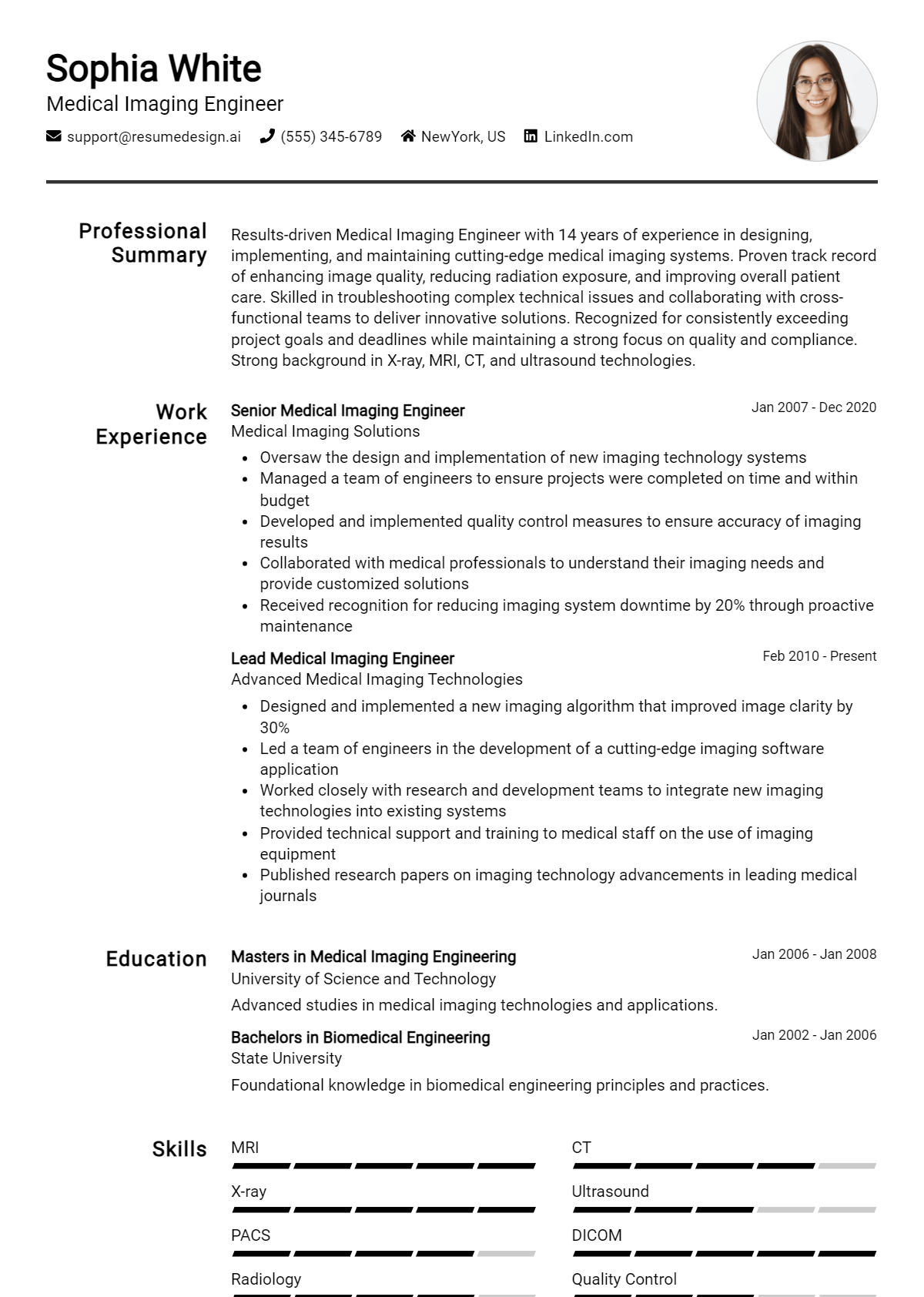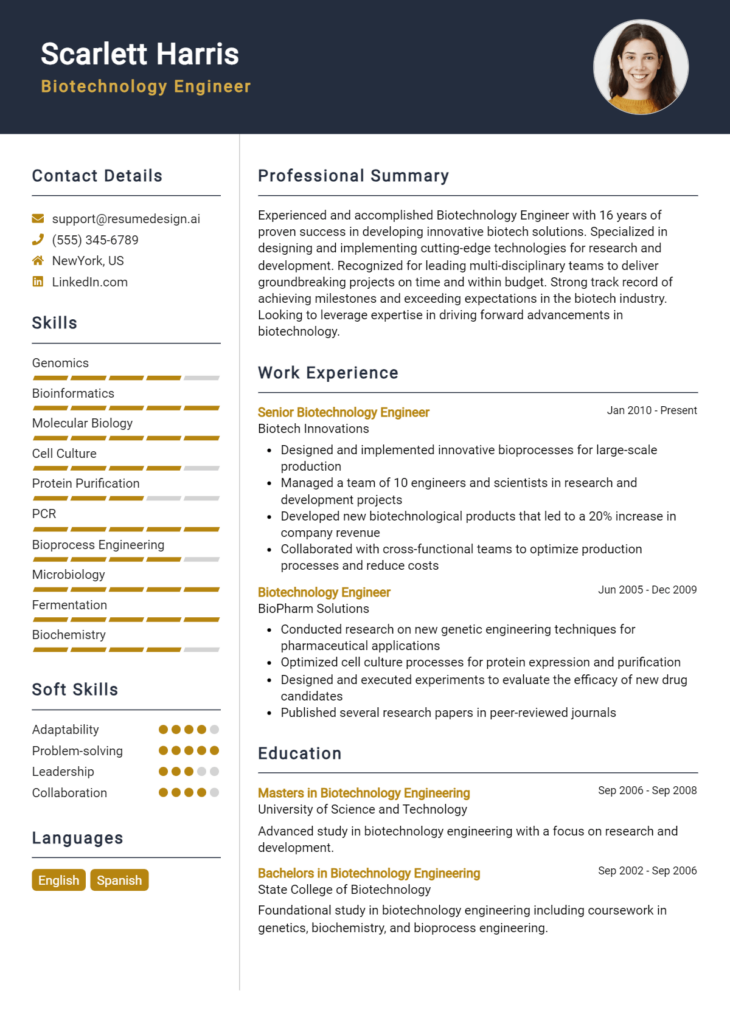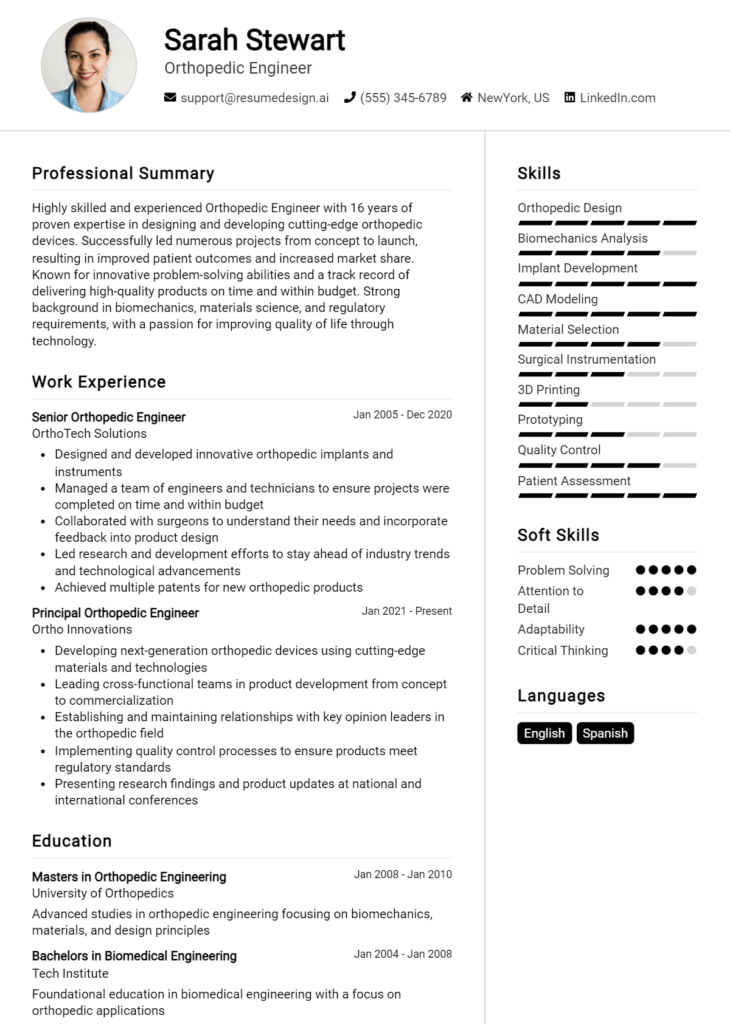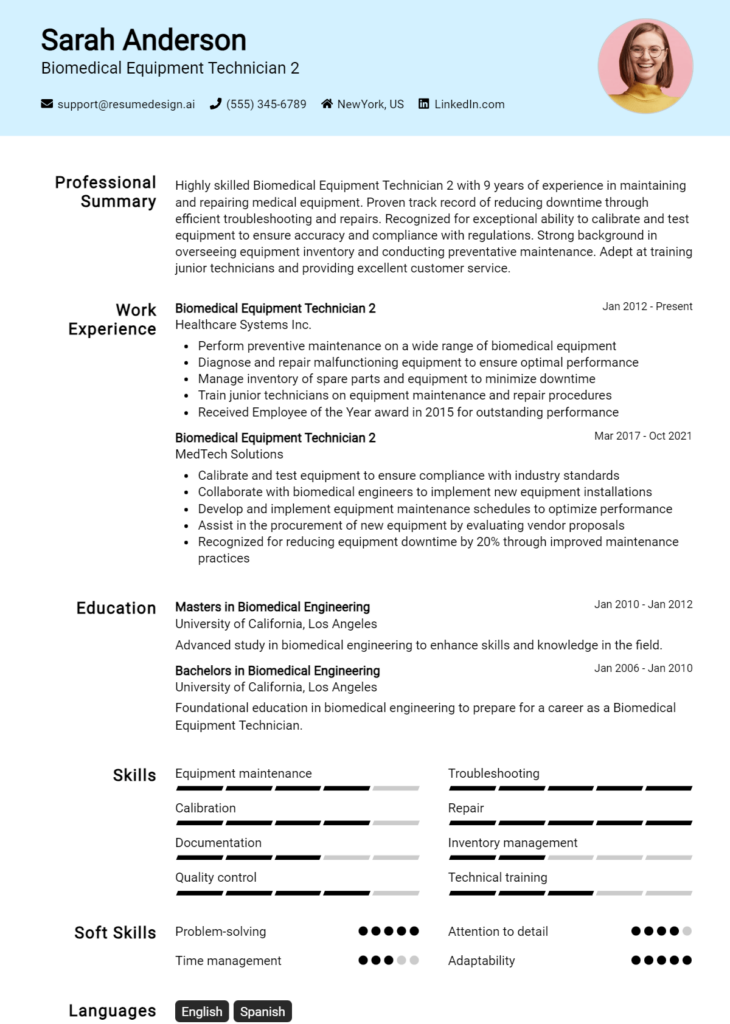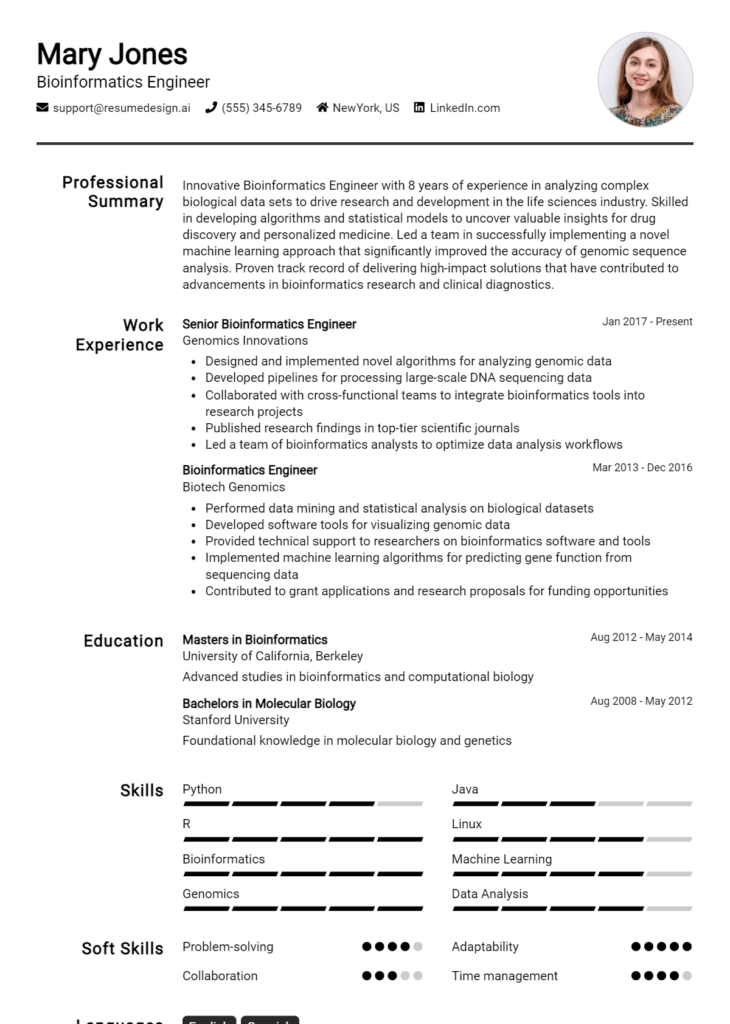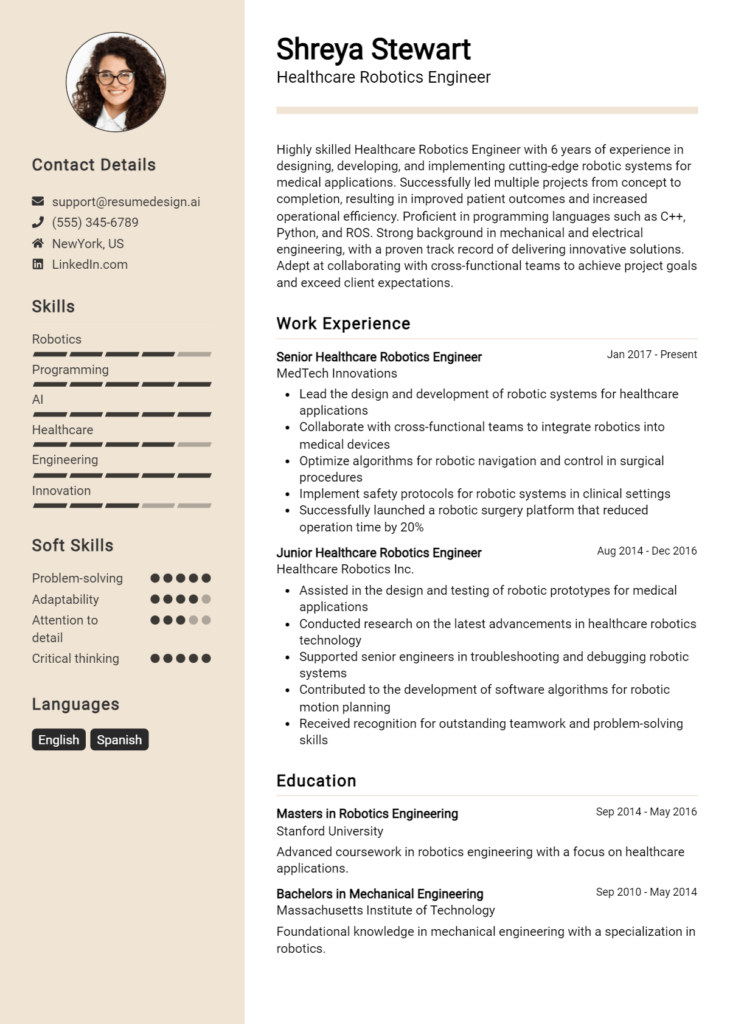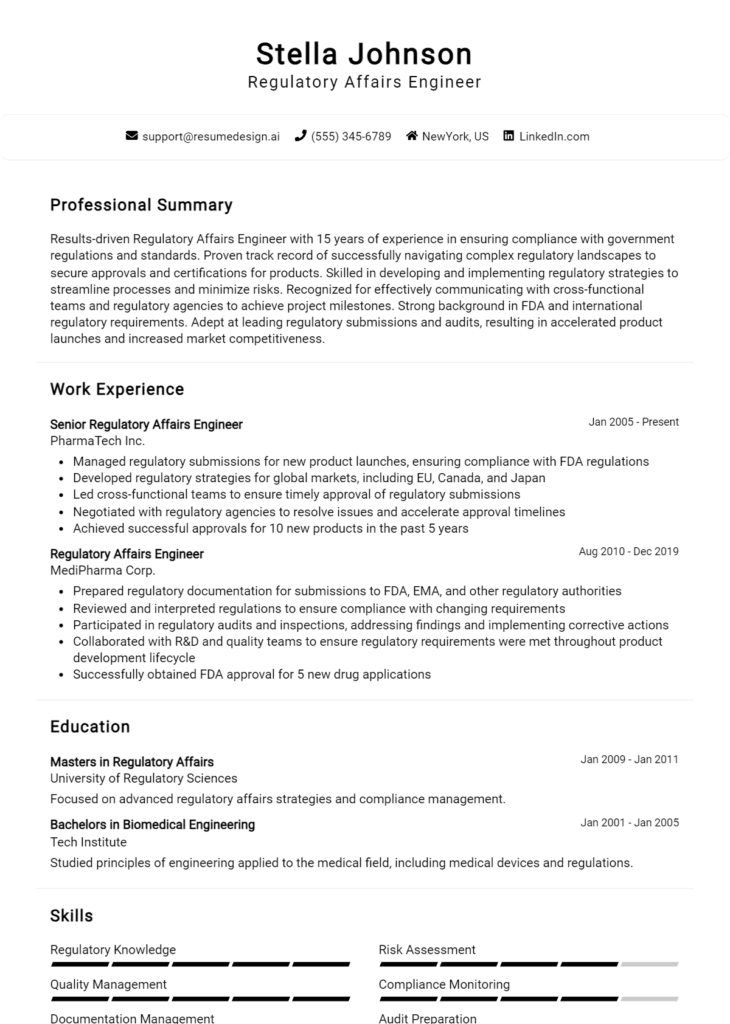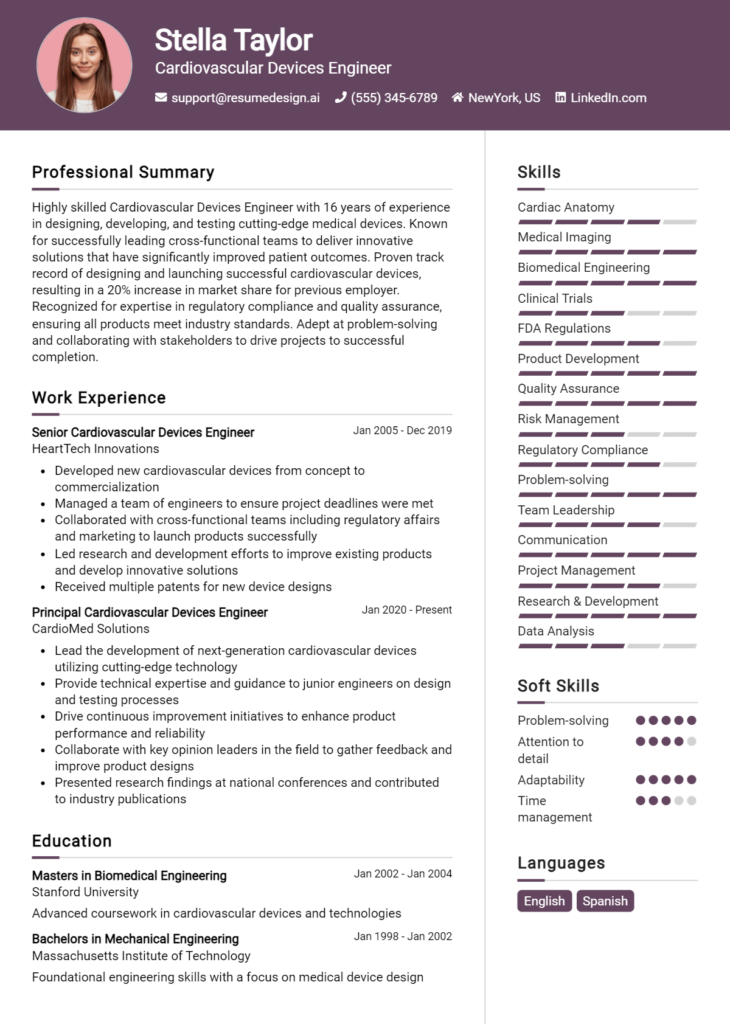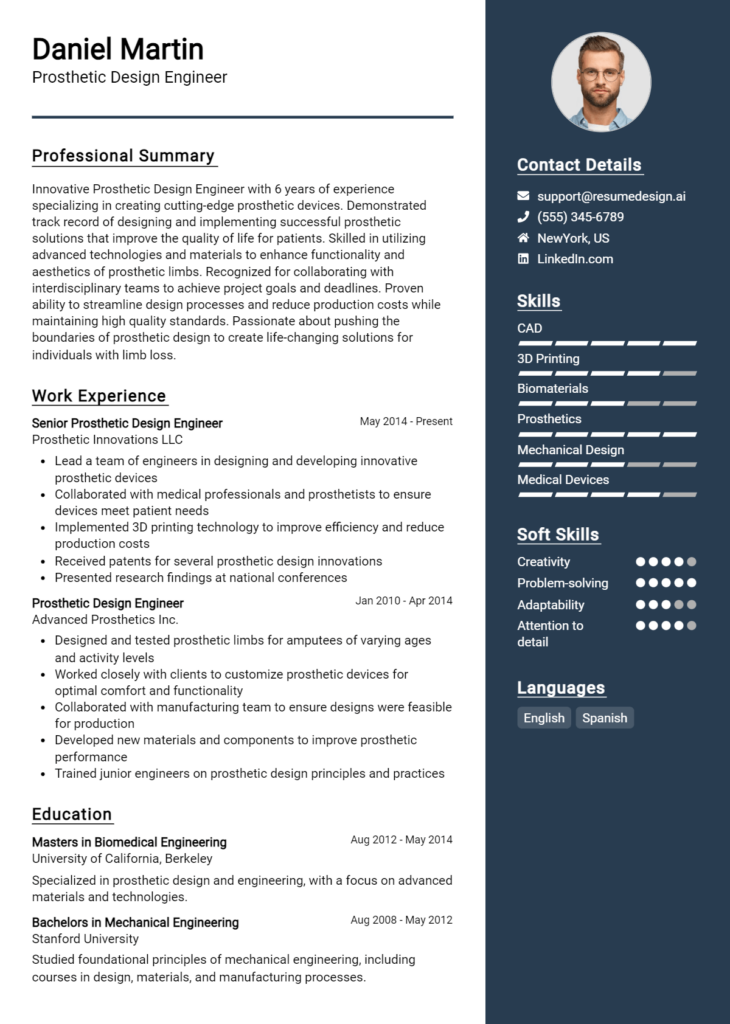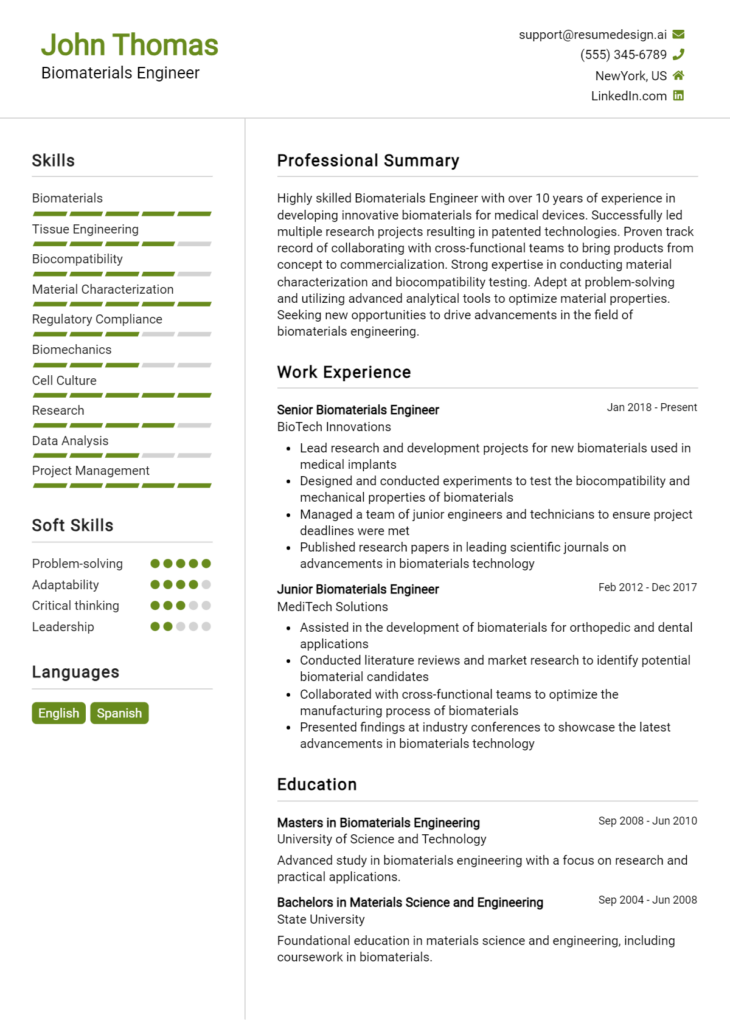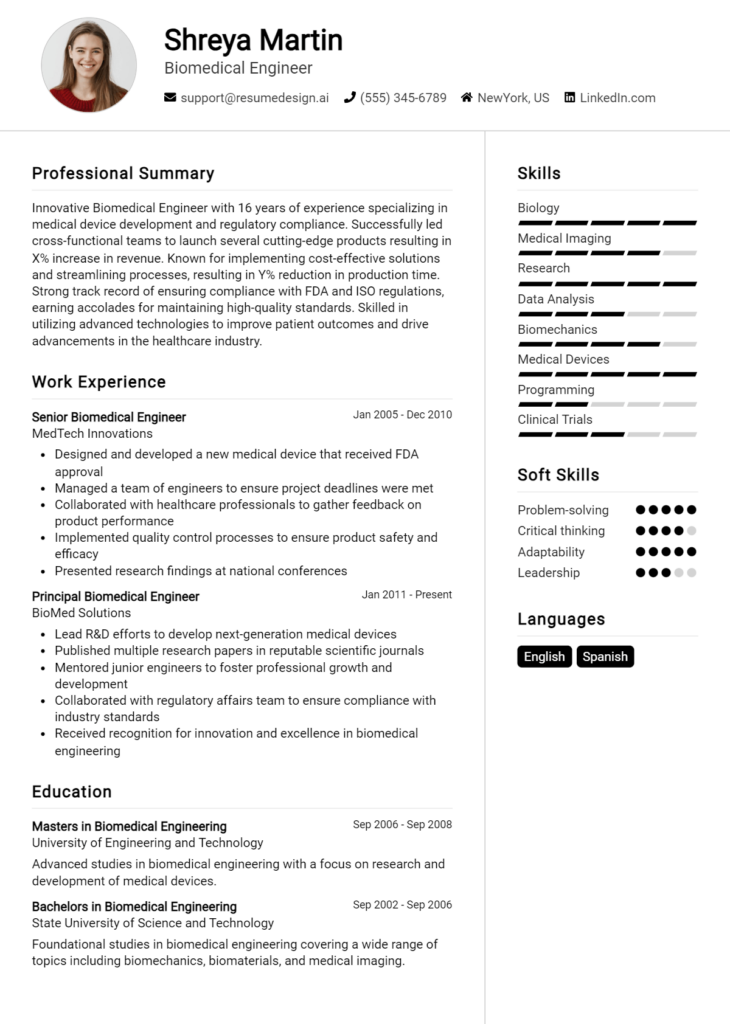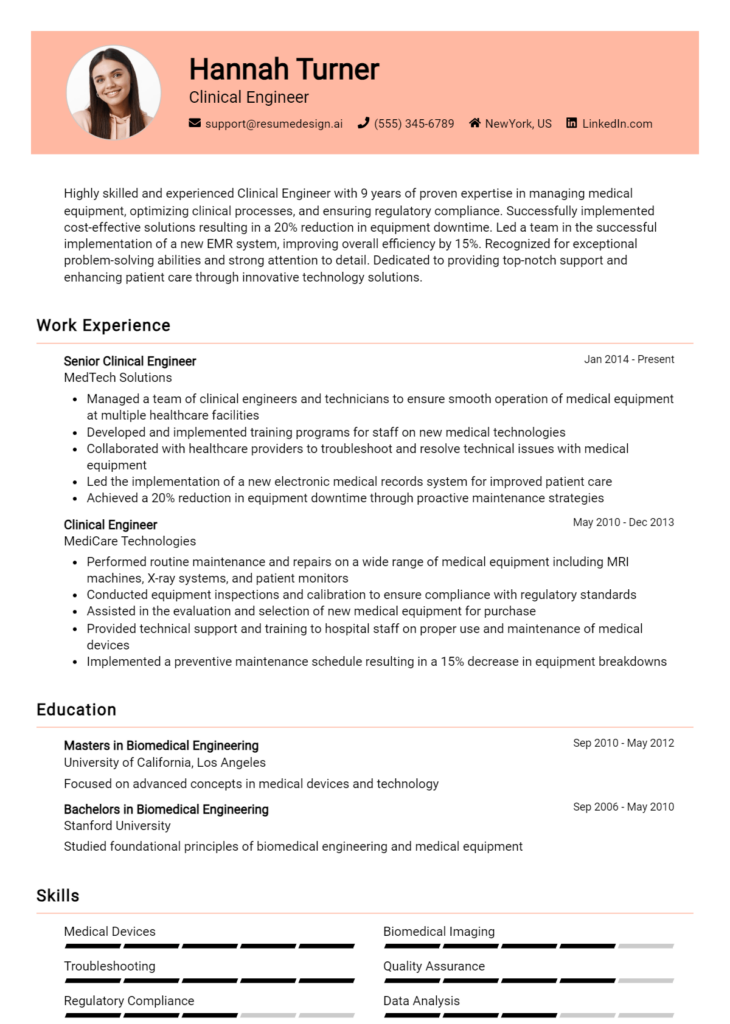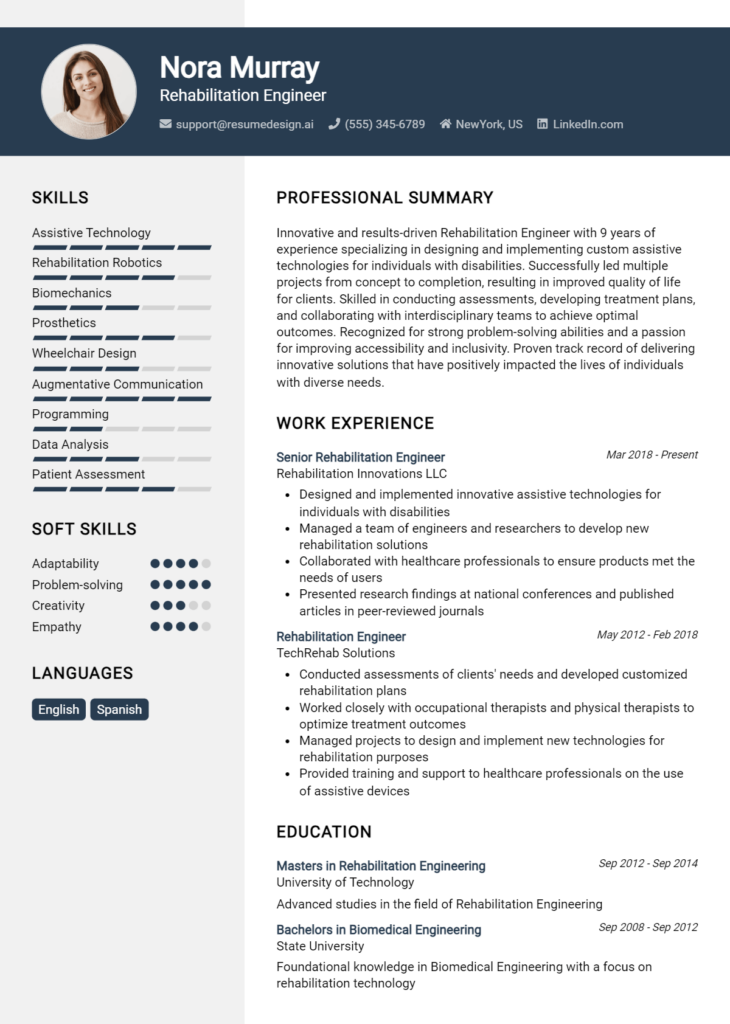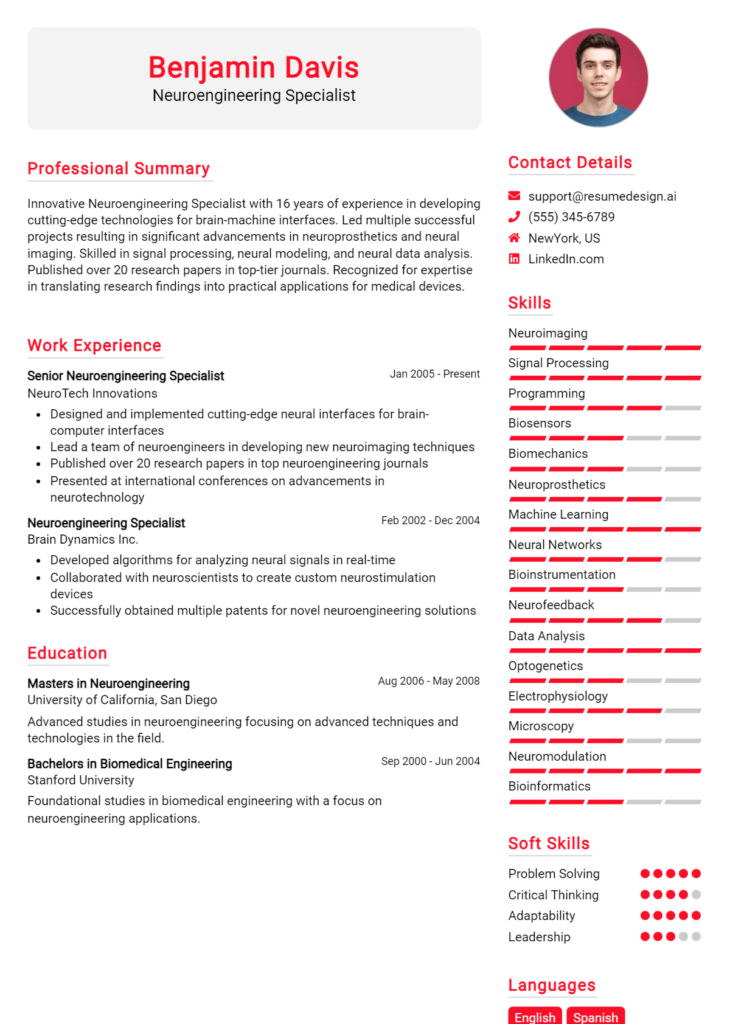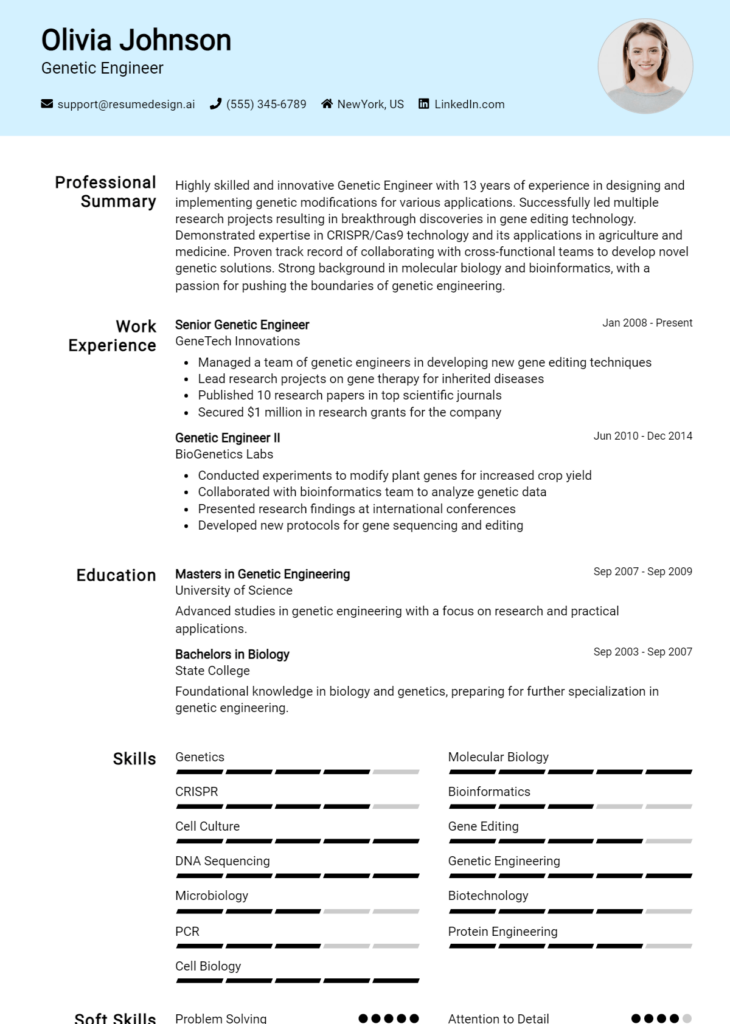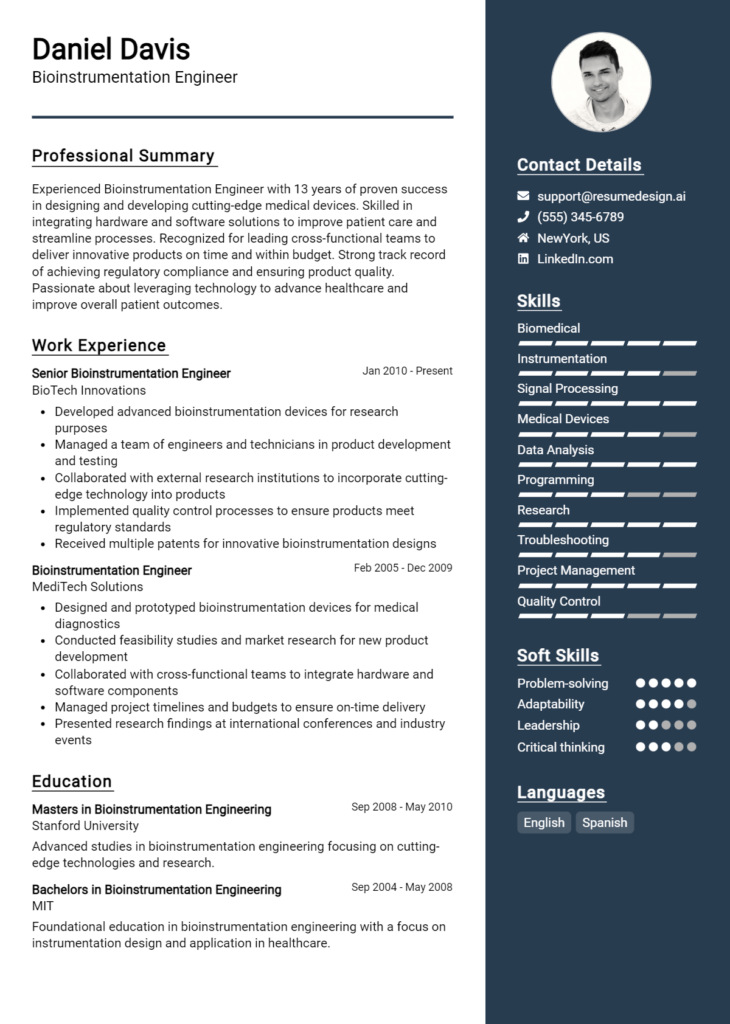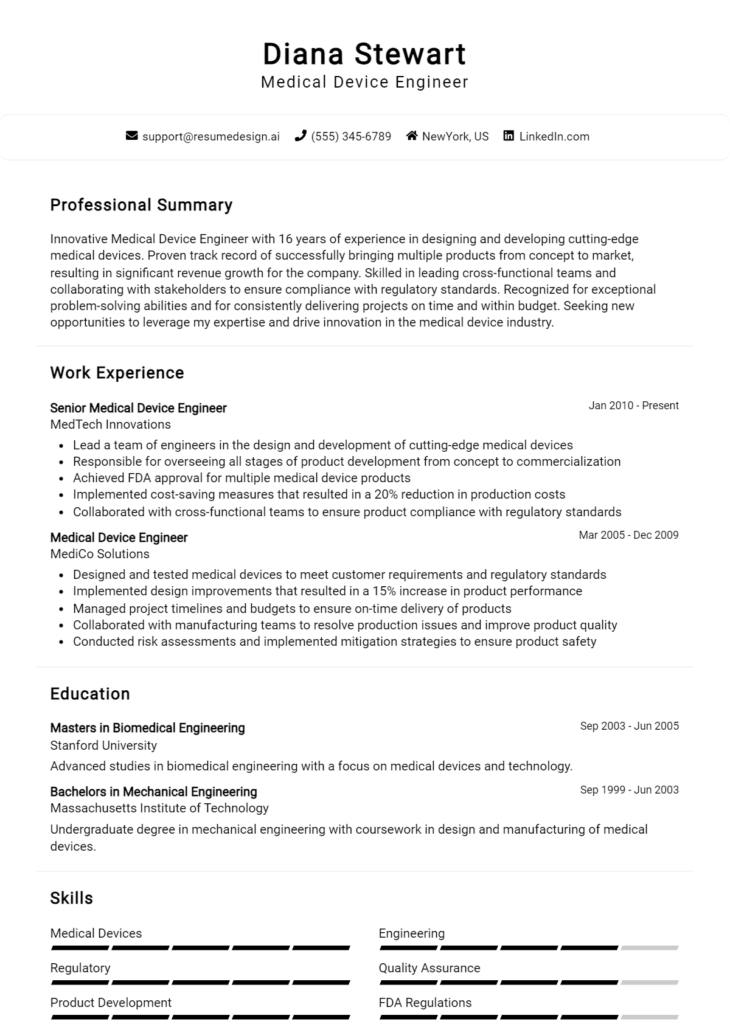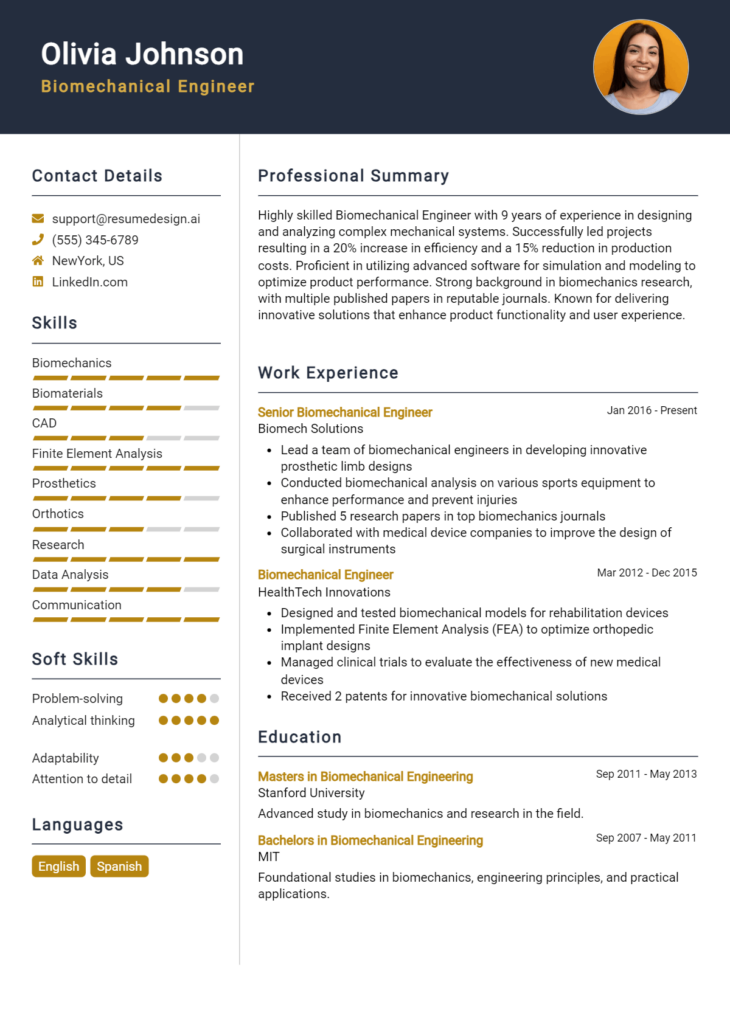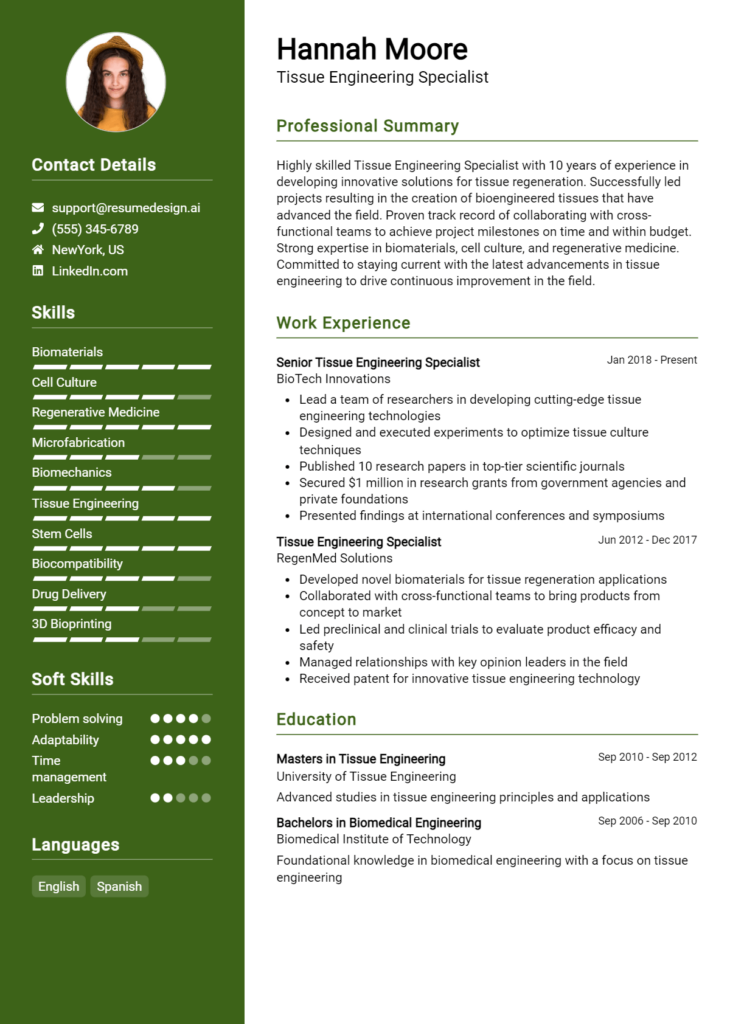Medical Imaging Engineer Core Responsibilities
A Medical Imaging Engineer plays a crucial role in healthcare, bridging the gap between technology and patient care. Key responsibilities include maintaining imaging equipment, ensuring compliance with safety standards, and collaborating with radiologists and IT departments to optimize imaging processes. The role demands strong technical knowledge, operational expertise, and advanced problem-solving skills to troubleshoot equipment issues effectively. These competencies are vital for enhancing diagnostic accuracy and improving patient outcomes, making a well-structured resume essential for showcasing these qualifications to potential employers.
Common Responsibilities Listed on Medical Imaging Engineer Resume
- Maintain and calibrate medical imaging equipment, including MRI, CT, and ultrasound machines.
- Ensure compliance with health and safety regulations and standards.
- Collaborate with radiologists and healthcare professionals to optimize imaging techniques.
- Conduct regular performance testing and quality assurance on imaging systems.
- Diagnose and resolve technical issues related to imaging devices.
- Provide technical support and training to medical staff on imaging equipment usage.
- Document maintenance procedures and equipment performance reports.
- Stay updated on advancements in imaging technology and techniques.
- Participate in research and development projects for new imaging solutions.
- Assist in the budgeting and procurement of imaging equipment.
- Ensure effective communication between engineering, clinical, and administrative teams.
High-Level Resume Tips for Medical Imaging Engineer Professionals
In the highly specialized field of medical imaging, a well-crafted resume is crucial for professionals aiming to make a lasting impression on potential employers. Your resume often serves as the initial point of contact, and it's essential that it reflects not only your technical skills and expertise but also your achievements and contributions within the industry. A standout resume can help you convey your qualifications and set you apart in a competitive job market. This guide will provide practical and actionable resume tips specifically tailored for Medical Imaging Engineer professionals, ensuring that you present your best self to prospective employers.
Top Resume Tips for Medical Imaging Engineer Professionals
- Tailor your resume to align with the specific job description, emphasizing the skills and experiences that match the employer's needs.
- Highlight relevant experience in medical imaging technologies, such as MRI, CT, and ultrasound, showcasing your proficiency in each area.
- Quantify your achievements by including metrics, such as reduction in downtime or improvements in imaging quality, to demonstrate your impact.
- Include certifications and licenses relevant to medical imaging, such as ARRT or ACR accreditation, to validate your expertise.
- Showcase your knowledge of regulatory standards and compliance, emphasizing your familiarity with FDA and HIPAA requirements.
- Use action verbs to describe your responsibilities and achievements, making your contributions clear and impactful.
- Incorporate industry-specific keywords to pass through Applicant Tracking Systems (ATS) and increase visibility to hiring managers.
- Highlight collaboration skills by mentioning any cross-functional teams you've worked with, showcasing your ability to communicate effectively with healthcare professionals.
- Keep your resume concise—ideally one page—while ensuring that all critical information is included to maintain the reader's interest.
- Consider including a summary statement that encapsulates your career goals and key qualifications, providing a snapshot of your professional identity.
Implementing these tips can significantly enhance your chances of landing a job in the Medical Imaging Engineer field. By presenting a polished, tailored resume that effectively showcases your skills and accomplishments, you position yourself as a strong candidate who stands out in the competitive landscape of medical imaging professionals.
Why Resume Headlines & Titles are Important for Medical Imaging Engineer
In the competitive field of medical imaging engineering, a well-crafted resume headline or title serves as a crucial first impression for hiring managers. This succinct phrase encapsulates a candidate's core qualifications and expertise, making it essential for standing out in a crowded applicant pool. A strong headline not only grabs attention but also provides a snapshot of the applicant's key skills and experiences relevant to the position. It should be concise, impactful, and directly aligned with the job being pursued, thereby setting the tone for the entire resume and encouraging the reader to delve deeper into the candidate's qualifications.
Best Practices for Crafting Resume Headlines for Medical Imaging Engineer
- Keep it concise—aim for one impactful phrase.
- Make it role-specific to highlight relevance to the position.
- Incorporate industry-specific keywords to enhance visibility.
- Showcase key qualifications or experiences that align with the job description.
- Avoid generic terms; be specific about your expertise.
- Use active language to convey a sense of confidence and proactivity.
- Consider including quantifiable achievements to demonstrate impact.
- Tailor your headline for each application to reflect the specific role.
Example Resume Headlines for Medical Imaging Engineer
Strong Resume Headlines
"Certified Medical Imaging Engineer with 5+ Years in MRI and CT Technology"
“Innovative Medical Imaging Engineer Specializing in Advanced Imaging Techniques and Patient Safety”
“Results-Driven Medical Imaging Specialist with Proven Track Record in Equipment Optimization”
“Experienced Medical Imaging Engineer with Expertise in Regulatory Compliance and Quality Assurance”
Weak Resume Headlines
“Medical Imaging Engineer Looking for Opportunities”
“Engineer with a Degree in Medical Imaging”
The strong headlines are effective because they clearly communicate the candidate's unique qualifications and areas of expertise, making them memorable and relevant to hiring managers. They incorporate specific skills and achievements, which helps to create a favorable impression. On the other hand, the weak headlines fail to impress due to their vagueness and lack of specificity; they do not convey the candidate's value or distinctiveness, making it easy for hiring managers to overlook them in favor of more compelling applications.
Writing an Exceptional Medical Imaging Engineer Resume Summary
A well-crafted resume summary is crucial for a Medical Imaging Engineer as it serves as the first impression for potential employers. This concise paragraph is designed to quickly capture the attention of hiring managers, effectively showcasing key skills, relevant experience, and notable accomplishments that align with the job role. A strong summary not only highlights the candidate's technical expertise in medical imaging technologies and systems but also emphasizes their ability to contribute to patient care and clinical outcomes. By being impactful and tailored to the specific job description, a resume summary can significantly increase the likelihood of securing an interview.
Best Practices for Writing a Medical Imaging Engineer Resume Summary
- Quantify Achievements: Use numbers to illustrate your impact, such as improved imaging efficiency or reduced downtime.
- Focus on Relevant Skills: Highlight specific technical skills related to medical imaging technologies, such as MRI, CT, and ultrasound.
- Tailor to the Job Description: Customize your summary based on the job requirements to demonstrate your fit for the role.
- Be Concise: Limit your summary to 3-4 sentences to maintain clarity and impact.
- Use Action Verbs: Start sentences with strong action verbs to convey your contributions effectively.
- Highlight Certifications: Mention any relevant certifications or advanced training in medical imaging.
- Showcase Interpersonal Skills: Include soft skills such as teamwork and communication, which are vital in a healthcare environment.
Example Medical Imaging Engineer Resume Summaries
Strong Resume Summaries
Detail-oriented Medical Imaging Engineer with over 7 years of experience in MRI and CT technology. Successfully reduced equipment downtime by 30% through proactive maintenance schedules and technician training programs, resulting in enhanced patient throughput.
Dedicated Medical Imaging Engineer skilled in ultrasound and imaging software, with a proven track record of improving image quality by 25% through innovative calibration techniques. Holds ARRT certification and committed to upholding high standards of patient care.
Results-driven Medical Imaging Engineer with expertise in digital imaging systems and a focus on optimizing workflows. Spearheaded a project that decreased processing time by 15%, contributing to improved diagnostic accuracy and patient outcomes.
Weak Resume Summaries
Experienced engineer looking for a position in medical imaging. I have worked with various imaging machines and am eager to contribute to a healthcare team.
Medical Imaging Engineer with some experience in the field. Interested in further developing my career and skills in medical technology.
The strong resume summaries are effective because they clearly outline specific achievements, relevant skills, and quantifiable results that demonstrate the candidate's impact in previous roles. In contrast, the weak summaries lack detail, specificity, and measurable outcomes, making them less appealing to hiring managers who seek candidates with proven expertise and a track record of success in the medical imaging field.
Work Experience Section for Medical Imaging Engineer Resume
The work experience section of a Medical Imaging Engineer resume is essential as it highlights the candidate's technical skills, leadership capabilities, and ability to deliver high-quality medical imaging products. This section serves as a platform to demonstrate hands-on experience with imaging technologies, project management, and team collaboration. By quantifying achievements and aligning work experience with industry standards, candidates can effectively illustrate their value and readiness to contribute to potential employers in the healthcare and imaging sectors.
Best Practices for Medical Imaging Engineer Work Experience
- Use specific technical terminology relevant to medical imaging, such as MRI, CT, and ultrasound.
- Quantify results where possible, using metrics such as improved imaging quality percentages or reduced processing times.
- Highlight leadership roles in projects, showcasing your ability to manage teams and drive project success.
- Detail collaborative efforts with healthcare professionals to emphasize your interdisciplinary approach.
- Include relevant certifications or training that align with your work experience.
- Focus on achievements that align with industry standards and best practices in medical imaging.
- Use active language to convey your contributions and responsibilities clearly.
- Tailor your experience to match the requirements of the job you are applying for, demonstrating your fit for the role.
Example Work Experiences for Medical Imaging Engineer
Strong Experiences
- Led a cross-functional team in the development of a state-of-the-art MRI imaging system, resulting in a 30% increase in image resolution and a 20% reduction in scan times.
- Implemented a quality assurance protocol that reduced imaging errors by 15%, significantly enhancing patient diagnostic accuracy.
- Collaborated with radiologists to design a new ultrasound application, which improved user interface satisfaction scores by 25% based on post-implementation surveys.
- Managed the successful installation of advanced CT scanners across three hospitals, completing the project two weeks ahead of schedule and under budget.
Weak Experiences
- Worked on medical imaging projects without specifying the technology or outcomes achieved.
- Assisted in various tasks related to imaging without detailing any specific contributions or accomplishments.
- Participated in team meetings about imaging systems but did not provide any measurable impacts or results from those discussions.
- Involved in imaging technology maintenance with no quantifiable improvements or efficiencies noted.
The strong experiences are considered effective because they demonstrate clear, quantifiable outcomes, leadership in projects, and collaboration with key stakeholders, showcasing the candidate's direct impact on organizational success. In contrast, the weak experiences lack specificity and measurable achievements, making them less compelling and failing to illustrate the candidate's true capabilities in the medical imaging field.
Education and Certifications Section for Medical Imaging Engineer Resume
The education and certifications section of a Medical Imaging Engineer resume is crucial for showcasing a candidate's academic qualifications and professional development. This section not only reflects the foundational knowledge gained from relevant degrees but also illustrates the candidate's commitment to industry standards through certifications and specialized training. By detailing pertinent coursework, certifications, and ongoing educational pursuits, candidates can significantly enhance their credibility and demonstrate their alignment with the specific requirements of the job role.
Best Practices for Medical Imaging Engineer Education and Certifications
- Focus on relevant degrees such as Biomedical Engineering, Medical Imaging Technology, or Radiologic Sciences.
- Include industry-recognized certifications like ARRT (American Registry of Radiologic Technologists) or CBET (Certified Biomedical Equipment Technician).
- Highlight specialized training in advanced imaging technologies such as MRI, CT, or ultrasound.
- Detail any relevant coursework that demonstrates proficiency in medical imaging principles and technologies.
- Keep the information up-to-date; remove outdated certifications or irrelevant degrees.
- Present certifications in order of relevance and importance to the position applied for.
- Utilize bullet points for clarity and to enhance readability.
- Consider including continuing education credits or workshops that pertain to the field.
Example Education and Certifications for Medical Imaging Engineer
Strong Examples
- Bachelor of Science in Biomedical Engineering, XYZ University, Graduated May 2021
- ARRT Certified Radiologic Technologist, Active since June 2020
- Advanced MRI Techniques Certification, ABC Institute, Completed January 2022
- Relevant Coursework: Medical Imaging Systems, Radiation Physics, and Image Processing
Weak Examples
- Bachelor of Arts in Sociology, ABC University, Graduated May 2019
- Certification in Basic CPR, Completed March 2021
- Outdated Certificate in Film-Based Radiography, Expired December 2018
- Relevant Coursework: Introduction to Psychology, Completed December 2019
The strong examples are considered effective because they directly align with the qualifications and skills sought in a Medical Imaging Engineer role, showcasing relevant degrees, up-to-date certifications, and pertinent coursework. In contrast, the weak examples illustrate a disconnect from the field, including irrelevant degrees and outdated certifications, which fail to demonstrate the candidate's qualifications for the position.
Top Skills & Keywords for Medical Imaging Engineer Resume
As a Medical Imaging Engineer, possessing the right skills is crucial for crafting an effective resume that stands out to potential employers. The field of medical imaging is highly technical and continuously evolving, requiring professionals to not only have a firm grasp of advanced imaging technologies but also to possess strong interpersonal and problem-solving abilities. Highlighting both hard and soft skills on your resume can showcase your comprehensive expertise and adaptability in this specialized area. A well-rounded skill set is essential for ensuring you can contribute effectively to a multidisciplinary team focused on enhancing patient care through innovative imaging solutions.
Top Hard & Soft Skills for Medical Imaging Engineer
Soft Skills
- Strong communication skills
- Team collaboration
- Problem-solving ability
- Attention to detail
- Critical thinking
- Time management
- Adaptability
- Empathy towards patients
- Analytical thinking
- Project management
Hard Skills
- Proficiency in imaging software (e.g., DICOM, PACS)
- Knowledge of MRI, CT, and ultrasound technologies
- Understanding of radiographic principles
- Technical troubleshooting
- Experience with quality assurance protocols
- Familiarity with regulatory standards (e.g., FDA, ISO)
- Expertise in medical device design and development
- Programming skills (e.g., C++, Python)
- Data analysis and interpretation
- Electrical and mechanical systems knowledge
By focusing on these essential skills and aligning them with your work experience, you can create a compelling resume that highlights your qualifications as a Medical Imaging Engineer.
Stand Out with a Winning Medical Imaging Engineer Cover Letter
As a dedicated Medical Imaging Engineer with over five years of experience in developing and optimizing imaging systems, I am excited to apply for the position at [Company Name]. My background in biomedical engineering, coupled with my expertise in advanced imaging technologies, has equipped me with the skills to contribute effectively to your team. I am particularly drawn to your commitment to innovation and excellence in patient care, which aligns perfectly with my professional values and aspirations.
In my previous role at [Previous Company Name], I successfully led a project to enhance the performance of MRI systems, resulting in a 20% increase in imaging resolution and a significant reduction in patient scan times. I collaborated closely with cross-functional teams, including radiologists and software developers, to ensure that the imaging systems not only met clinical standards but also improved patient experience. My strong analytical skills, combined with my hands-on experience in troubleshooting and maintaining imaging equipment, have allowed me to effectively address challenges and implement solutions that enhance operational efficiency.
I am particularly proficient in the integration of cutting-edge imaging technologies, such as 3D imaging and AI-driven diagnostic tools. My commitment to continuous learning drives me to stay updated with the latest advancements in medical imaging, ensuring that I bring innovative solutions to the table. I am excited about the possibility of contributing to [Company Name] and supporting your mission to provide top-tier imaging services that improve patient outcomes.
I appreciate your consideration of my application and would welcome the opportunity to discuss how my skills and experiences align with the goals of your team. I am eager to bring my expertise in medical imaging engineering to [Company Name] and contribute to the continued success and growth of your organization. Thank you for your time, and I look forward to the possibility of discussing my application further.
Common Mistakes to Avoid in a Medical Imaging Engineer Resume
When crafting a resume for the role of a Medical Imaging Engineer, it's crucial to present your qualifications and experiences effectively. Unfortunately, many candidates make common mistakes that can undermine their chances of landing an interview. By avoiding these pitfalls, you can enhance your resume's impact and better showcase your skills in medical imaging technology. Here are some common mistakes to steer clear of:
Vague Job Descriptions: Failing to provide specific details about previous roles can leave hiring managers confused about your actual responsibilities and achievements. Use quantifiable results when possible.
Ignoring Relevant Skills: Medical Imaging Engineers require a unique blend of technical and soft skills. Omitting critical skills like proficiency in specific imaging software or teamwork can weaken your application.
Lack of Keywords: Many companies use Applicant Tracking Systems (ATS) to filter resumes. Not incorporating industry-specific keywords can result in your resume being overlooked.
Overloading with Technical Jargon: While it's important to demonstrate technical knowledge, using excessive jargon can alienate non-technical hiring managers. Aim for clarity and accessibility.
Ignoring Formatting: A cluttered or overly complex resume format can distract from your qualifications. Use clean, professional formatting to enhance readability and presentation.
Neglecting Continuing Education: The medical imaging field is constantly evolving. Failing to mention ongoing training or certifications can suggest a lack of commitment to professional development.
Too Long or Too Short: A resume that is excessively long may overwhelm readers, while a very short resume might not provide enough information. Aim for a balanced length that covers your qualifications comprehensively without unnecessary filler.
Typos and Grammatical Errors: Simple mistakes can create a negative impression and suggest a lack of attention to detail. Always proofread your resume or have someone else review it before submission.
Conclusion
As a Medical Imaging Engineer, your role is pivotal in ensuring the functionality and safety of imaging devices that are crucial for diagnostic purposes. Your expertise in the design, development, and maintenance of imaging technologies like MRI, CT, and ultrasound systems not only enhances patient care but also contributes to the advancement of medical science.
With the increasing demand for skilled professionals in this field, it is essential to present a standout resume that highlights your technical skills, relevant experience, and educational background. Tailoring your resume to showcase your accomplishments and proficiency in medical imaging technologies can significantly improve your chances of landing your desired position.
To ensure your resume effectively communicates your qualifications, we encourage you to take advantage of various resources available to you. Explore resume templates that provide professional layouts tailored for your industry. Utilize the resume builder to create a customized resume that reflects your unique skills and experiences. Additionally, review resume examples to gain insights into how other successful Medical Imaging Engineers have presented their qualifications. Don’t forget to craft a compelling cover letter using the available cover letter templates to complement your resume.
In summary, now is the perfect time to review and refine your Medical Imaging Engineer resume. By leveraging these tools, you can enhance your job application and position yourself for success in this dynamic and rewarding field.

